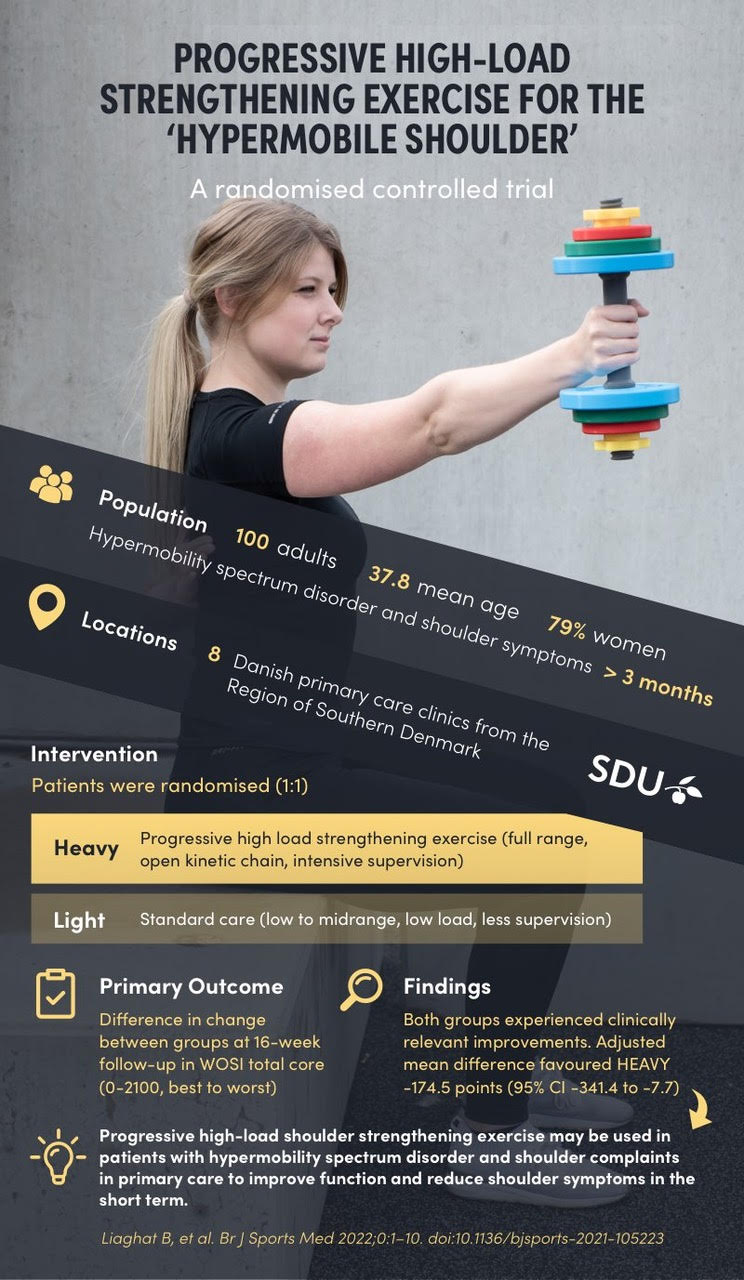Patients with ’hypermobile shoulders’ can safely improve shoulder function and physical symptoms with high load exercise
Why is this study important?
Joint hypermobility is defined as the ability to move the joints beyond the normal range of motion. Joint hypermobility may be advantageous in activities and sports where high flexibility is required. However, it may be symptomatic with, for example, chronic/recurrent pain, joint instability, and decreased ability to participate in basic daily activities. This clinical entity has been defined as ‘Hypermobility spectrum disorder’ (HSD). There is no gold standard management, and no randomised controlled trial had focused on treatment of the shoulder for this patient group.
How did the study go about this?
One-hundred patients from primary care in Denmark were randomised to receive either a progressive high-load strengthening exercise programme (full-range, open kinetic chain) or ’standard care’ consisting of low-load exercises (neutral to midrange). Patients fulfilled the clinical criteria for having HSD and shoulder symptoms for at least 3 months. After 16 weeks, the self-reported shoulder function was evaluated using a validated questionnaire for patients with shoulder instability.
What did the study find?
A supervised, progressive high-load shoulder strengthening exercise programme resulted in greater self-reported improvement in shoulder function than less supervised and less progressive low-load exercises at 16 weeks.
More than two-thirds of the patients receiving high-load strengthening exercise improved shoulder function above the threshold for minimal important difference, and 64% reported an important improvement in physical symptoms postintervention. The exercise programme was associated with no major but some minor adverse events like transient muscle soreness and headache.
What are the key take-home points?
The high-load shoulder strengthening exercise programme may be used in patients with HSD and shoulder symptoms in primary care to improve function and reduce shoulder symptoms in the short term.
Further studies are needed to confirm the clinical relevance and the long-term effectiveness. Clinicians should pay attention to and help the patients in managing associated minor adverse events.
Author names and affiliations
Behnam Liaghat,1 Søren T Skou,1,2 Jens Søndergaard,3 Eleanor Boyle,1 Karen Søgaard,1,4 Birgit Juul-Kristensen 1
1 Department of Sports Science and Clinical Biomechanics, University of Southern Denmark, Odense, Denmark
2 Department of Physiotherapy and Occupational Therapy, Næstved-Slagelse-Ringsted Hospitals, Slagelse, Denmark
3 Department of Public Health, University of Southern Denmark, Odense, Denmark
4 Department of Clinical Research, University of Southern Denmark, Odense, Denmark